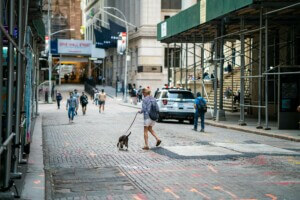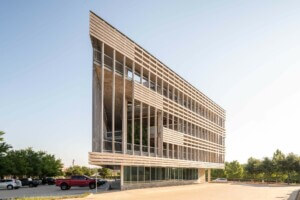With the goal of becoming a net zero building, The Bloomberg Center, designed by Morphosis, forms the heart of the new Cornell Tech campus on Roosevelt Island, bridging academia and industry while pioneering new standards in environmental sustainability through state-of-the-art design.
- Facade Manufacturer
Island Exterior Fabricators - Architects
Morphosis - Facade Installer
W&W Glass, LLC (unitized curtain wall); Island Exterior Fabricators; Barr & Barr (general contractor) - Facade Consultants
ARUP (facade, structural, MEP/FP engineering, sustainability; lighting; acoustical; av/it/smart building) - Location
Roosevelt Island, New York, NY - Date of Completion
2017 - System
unitized continuously insulated rainscreen; photo voltaic solar canopy - Products
Louvered ZIRA system from A. Zahner Company; Custom Unitized Curtain Wall; Custom Curved Glass Enclosure
Spearheaded by Morphosis’ Pritzker Prize-winning founder Thom Mayne and principal Ung-Joo Scott Lee, The Bloomberg Center is the intellectual nerve center of the campus, reflecting the school’s joint goals of creativity and excellence by providing academic spaces that foster collective enterprise and collaboration.
“The aim of Cornell Tech to create an urban center for interdisciplinary research and innovation is very much in line with our vision at Morphosis, where we are constantly developing new ways to achieve ever-more-sustainable buildings and to spark greater connections among the people who use our buildings. With the Bloomberg Center, we’ve pushed the boundaries of current energy efficiency practices and set a new standard for building development in New York City,” said Morphosis founder and design director Thom Mayne in a press release.
The four-story, 160,000-square-foot academic building is named in honor of Emma and Georgina Bloomberg in recognition of a $100-million gift from Michael Bloomberg, who was responsible for bringing Cornell Tech to New York City while serving as the city’s 108th Mayor.
A major feature of the building is an expansive photovoltaic canopy, with a low and narrow profile that frames views across the island. One of the building’s most distinctive features is its facade, optimized to balance transparency—maximizing daylighting and exterior views, and opacity—maximizing insulation and reducing thermal bridging.
Designed as a rain screen system, the outermost layer of the facade is composed of aluminum panels surfaced in an iridescent, PPG polymer coating. Viewed from afar, the aluminum panels register a continuous image that merges the river-view scenery from Cornell Tech’s Roosevelt Island location and Cornell University’s idyllic campus in Ithaca, New York. Facing the city, the Bloomberg Center’s west facade registers the image of the Manhattan skyline as it is viewed directly across the East River. Along the campus’ main entry and central circulation spine (the “Tech Walk”), the east facade registers an image of Ithaca’s famous gorges.
Designed in collaboration with A. Zahner Company, an architectural metal fabricator, the facade utilizes Zahner’s Louvered ZIRA system to create the image patterning. Each pixel of the image is translated into the specific turn-and-tilt of a two-inch circular tab punched into the aluminum paneling; the depth and rotation of each tab determine the amount of light reflected. This pixel map was fed into a repurposed welding robot, which processed the digital information into the mechanical turning-and-tilting of the facade’s 337,500 tabs. The algorithm controlling the robot was developed in collaboration with Cornell and MIT students.
“Our collaboration with the Cornell and MIT students to develop the building’s facade is an example of the type of connections that Cornell Tech will foster between academia and tech industries,” said Ung-Joo Scott Lee, Principal at Morphosis and Project Principal of the Bloomberg Center. “We were ultimately interested in demonstrating that designing for net-zero creates not only a more energy efficient building but, in fact, a healthier and more comfortable environment for its occupants. The very systems that provide our path to high building performance are the same systems that provide better control to its users while giving the building its distinct identity. Cornell University’s leadership in sustainability is central to their mission; we look to continue that leadership in both upstate as well as downstate campuses.”
Morphosis will be participating in the upcoming Facades+ Los Angeles conference on October 19 to 20, 2017. Stan Su, who contributed to Bloomberg Center as a member of Morphosis’ Advanced Technology team, will be co-presenting a morning workshop along with Brad Prestbo (Director of Technical Resources, Sasaki Associates), Chris O’Hara (Founding Principal, Facades Director, Studio NYL). The workshop will be divided up into three parts: a group discussion on fundamental detailing principals, case study examples of how those principles are employed, and a hands-on session where the group will reverse-engineer details from notable projects.










